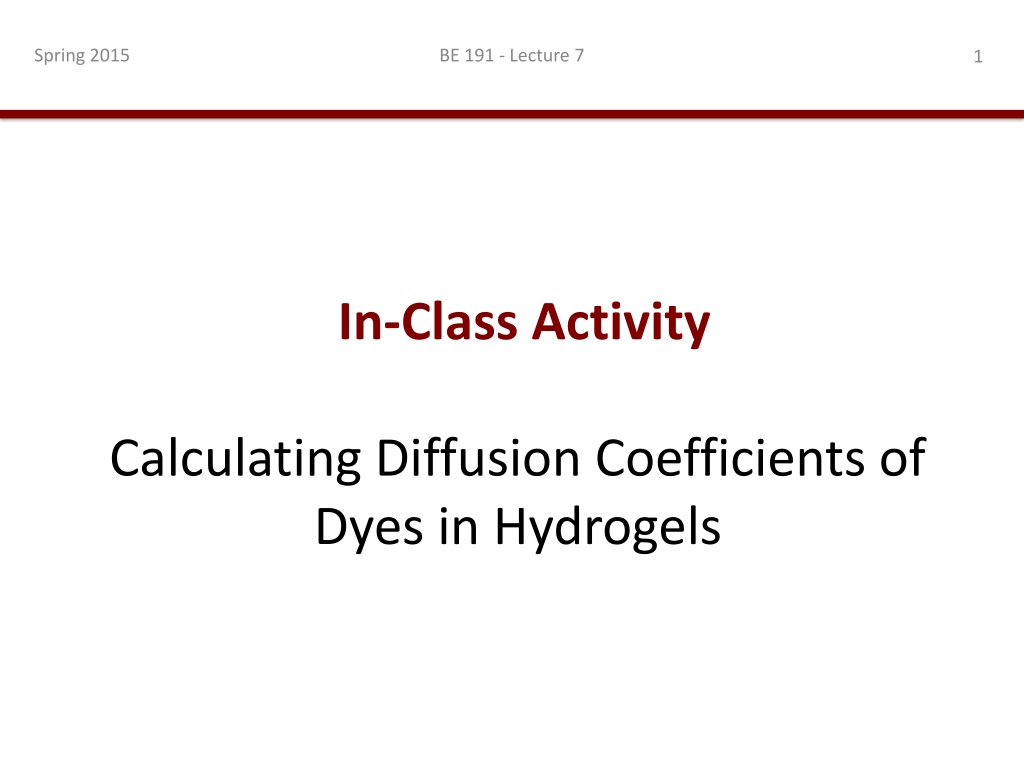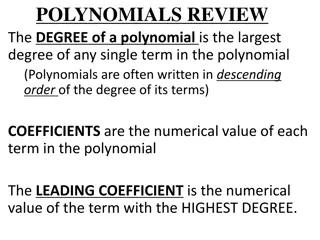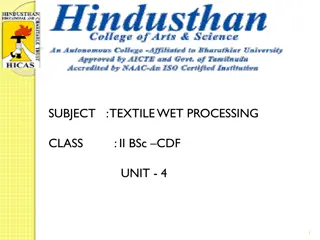Understanding Diffusion Coefficients of Dyes in Hydrogels
Explore the calculation of diffusion coefficients of dyes in hydrogels based on factors like molecular weight, matrix mesh size, temperature, and chemical properties. Learn through in-class activities to determine the diffusion coefficients in different hydrogel concentrations, assess the applicability of Fick's laws, and consider key factors influencing diffusion rates for designing controlled release systems and tissue constructs.
Download Presentation

Please find below an Image/Link to download the presentation.
The content on the website is provided AS IS for your information and personal use only. It may not be sold, licensed, or shared on other websites without obtaining consent from the author. Download presentation by click this link. If you encounter any issues during the download, it is possible that the publisher has removed the file from their server.
E N D
Presentation Transcript
Spring 2015 BE 191 - Lecture 7 1 In-Class Activity Calculating Diffusion Coefficients of Dyes in Hydrogels
Spring 2015 BE 191 - Lecture 7 2 Important Considerations Understanding diffusion is key to designing controlled release systems and fabricating engineered tissue constructs Diffusion rates depend not only on the size of a molecule, but also many other factors, including: Molecular weight of diffusing species Matrix mesh size Temperature Chemical/Structural properties of the diffusing species Interactions between diffusing species and the matrix
Spring 2015 BE 191 - Lecture 7 3 Measure Dye Diffusion Coefficients Split into teams, and receive the following from the TFs: 4 hydrogel samples with dye Two hydrogel samples were prepared at a concentration, X and two at a concentration, Y Concentrated? dye,? C(x=0)? =? Cs? x? =? 0? No? dye? in? hydrogel,? C(x>0)? =? C0?=? 0? x? =? x1? Do the following: 1. Determine whether Fick s First or Second Law applies to this case. 2. Next, estimate the diffusion coefficients of the dye molecules within each of these hydrogels. 3. Based on your results, which hydrogel concentration X or Y is higher? 4. If you wanted to achieve the same diffusivities at a fixed hydrogel concentration, what else could you change? x? =? x2? t? =? to? =? 0? t? =? t1? t? =? t2? *Hashmark spacing on the tubes is 3.17 mm t
Spring 2015 BE 191 - Lecture 7 4 Fick s Second Law x Concentrated dye, C(x=0) = Cs ( , ) C x t C erfc s 2 Dt - Concentration in hydrogel, C(x, t) x = 0 No dye in hydrogel, C(x>0) = C0 = 0 - Assume Cs remains constant for whole experiment x = x1 - 1D diffusion problem, assumes Cs and C0 are constant and the gel is infinitely long x = x2 t = to = 0 t = t1 t = t2
Spring 2015 BE 191 - Lecture 7 5 Estimate Dye Diffusion Coefficients Concentrated? dye,? C(x=0)? =? Cs? Make this plot & determine the slope for both cases! What did you find? x? =? 0? No? dye? in? hydrogel,? C(x>0)? =? C0?=? 0? x? =? x1? Slope = D x2 x? =? x2? t? =? to? =? 0? t? =? t1? t? =? t2? *Hashmark spacing on the tubes is 3.17 mm t A simple approach to estimate dye diffusivity in hydrogel matrices is to use: D = L2/t (units of cm2/sec)
Spring 2014 BE 191 - Lecture 1 6 Most agarose gels are between 0.7 - 2% dissolved in a suitable electrophoresis buffer Separating DNA by # of base pairs Due to its negatively charged (phosphate backbone), DNA towards the positively-charged anode EtBr The pore size of a 1% gel ~100 to 500 nm DNA stained with ethidium bromide























